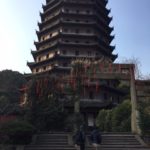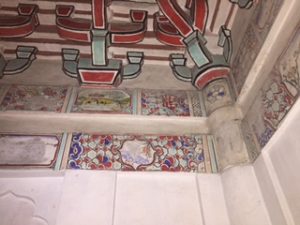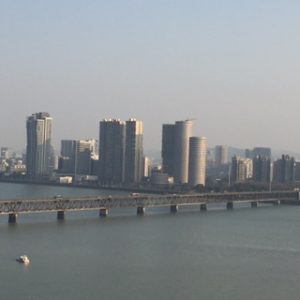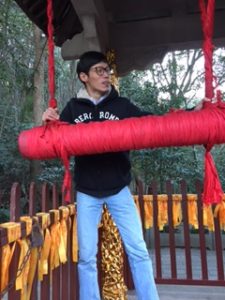14 January 2017 Saturday
The morning was spent with Professor Shen assessing repairs to “China 1908,” offering a glimpse into all the things that I do not know and have yet to learn, such as – oh, dear, too many too recount.
The afternoon was equally congenial, because, in fact, Professor Shen is always interesting and exciting to learn from, and we did talk about “China 1908,” THE BOOK, which is my favorite subject, but then the afternoon also took me away from the computer to outdoor research on The Book, for my friend Huapin Shen drove us to the Liuhe Six Harmonies Pagoda. That sentence is too long.
At the entry to Liuhe, we saw a poem, which liberally translated, instructed one to enjoy the sound of the moving tide while at Liuhe pagoda. This is appropriate. The Liuhe overlooks the broad and beautiful Qiantang River, so important to China’s history, for the Qiantang, once connected to the Grand Canal, brought ocean-going traffic and cargo all the way north to Beijing. In 1908, the six sedan chairs of Robert Fitch’s outing for the Gambles were parked near the base of the Liuhe Pagoda, while the chair occupants were exploring the site of the future Hangchow Christian College campus. “The children got nicely wet and dirty in the sand,” reports Clarence in his Journal for that day in 1908. He writes little more about the campus site, for there was little more to write. Sand there was (no wonder the children got “wet and dirty”), and sand was all there was. The area had long been denuded by aggressive lumber merchants.
After construction of the major college buildings was completed, with money from the Gambles, among others, students and faculty in the early twenties planted the hillsides extensively, and today the site is a veritable garden-park. The students of the Law Department of Zhejiang University, who now use the buildings, have a lovely setting in which to study, though more likely, to party. We are, after all, talking about college students. Nevertheless, the Gambles would be delighted to know that the buildings are, to this day, in service.
The original Liuhe Pagoda was built in 970 AD, but the current reconstruction with its slanting floors was built during the Qing (1643-1912) Dynasty Within, the steps that take the visitor to the top of the structure are, as expected, worn, steep, and uneven. The feet of those eighteenth-century monks must have been very small, for the steps are narrow; feet need to go sideways on them. Surely, the walls have been re-plastered. They are bare and whitish, and unless you know to look, you will never see what was once brightly colored artwork tha enlivens only the ceilings of small rooms around the center of the pagoda. Michelangelo it is not. Colors have obviously faded, but colorful geometric designs can be seen. What kind of monks painted these?
From the window openings of the pagoda, the view of the broad Qiantang River is beautiful. Through the mist, on the opposite bank, we saw towers of apartments and offices; the taller the tower, the more recently it was built, In the fall, the famous Hangzhou Bore, the largest in the world, courses past the Liuhe Pagoda, to reach historic heights where the river reaches the sea. Its rising beginnings are to be seen from the Pagoda, as are the daily tides, to which the entry poem refers. Every day, the boats, usually tied to the docks edging the river, draw to the river center to avoid crashing sides against the docks with the movement of the tide. We were there at just the right time to see the afternoon movement of the tide. We watched as the boats waited with great anticipation. It was, unfortunately for those of us who love drama, a very low tide on that cold, cloudy, intermittent sunshiny winter day, and all to be seen were some wide swaths of gentle swells. We did not hear anything, but we can say we saw a little something.
After the anti-climatic tide-viewing, we clambered down those steep, narrow, irregular steps and into the gray courtyard. A plaque proclaimed a monk who begged alms for ten years before he had sufficient funds to rebuild one of the many Liuhe econstructions. For that dedication, he, no doubt, enjoyed great satisfaction in his soul and earned, as well, a larger-than-life statue that sits before a great rock bank beside his plaque.
Viewing completed (oh yes, Huapin, also rang the gong), we went to another hill, to Siyanjing (translates Place of Four Wells), where rustic restaurants and student hotels are jammed into the hillside and into each other, and where the parked cars are jammed into each other. The road curving up to SIyanjing is extremely narrow and, curiously enough, a two-way street. I have no idea what happens when two cars meet each other. China drivers drive slowly and very, very close to one another – centimeters (millimeters?) within each other. There never seem to be any accidents, no doubt because driving is not fast, but I felt a lot of breath-holding moments as fenders skim by each other with a hair’s breadth between. So different from America, where a stretch of road means “speed up,” but individual cars will always demand a large personal zone of space around them, if it is





